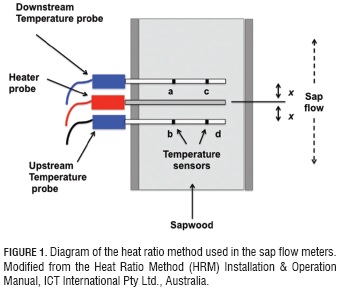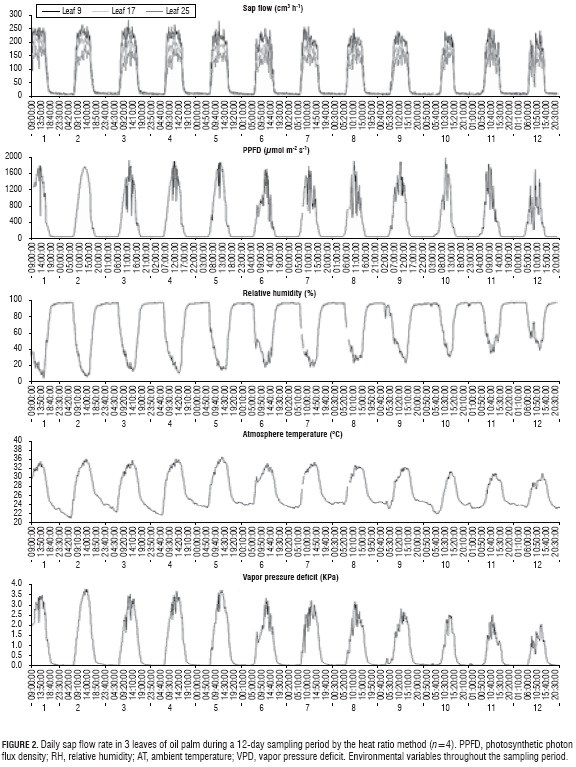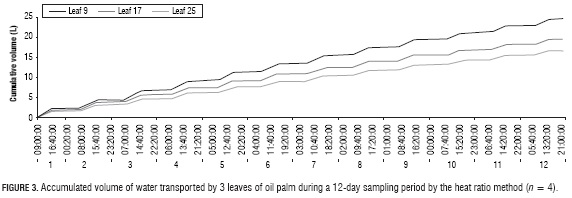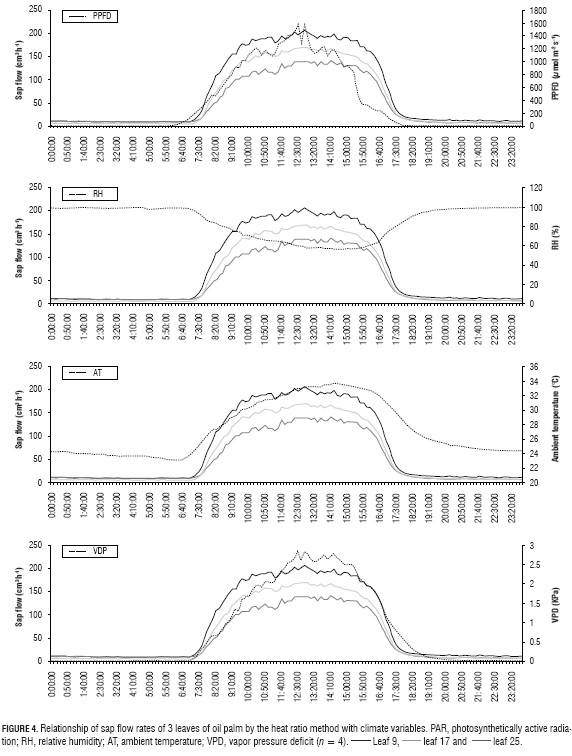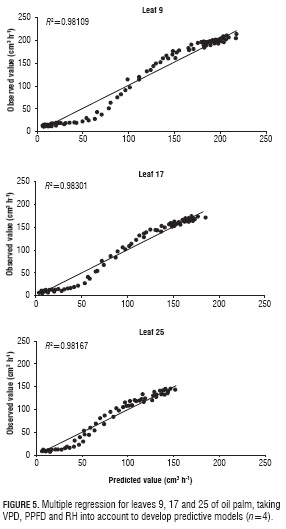Serviços Personalizados
Journal
Artigo
Indicadores
-
 Citado por SciELO
Citado por SciELO -
 Acessos
Acessos
Links relacionados
-
 Citado por Google
Citado por Google -
 Similares em
SciELO
Similares em
SciELO -
 Similares em Google
Similares em Google
Compartilhar
Agronomía Colombiana
versão impressa ISSN 0120-9965
Agron. colomb. vol.34 no.2 Bogotá maio/ago. 2016
https://doi.org/10.15446/agron.colomb.v34n2.55649
Doi: http://dx.doi.org/10.15446/agron.colomb.v34n2.55649
Estimation of transpiration in oil palm (Elaeis guineensis Jacq.) with the heat ratio method
Estimación de la transpiración en palma de aceite (Elaeis guineensis Jacq.) por el método del radio de calor
Cristihian Jarri Bayona-Rodríguez1 and Hernán Mauricio Romero1,2
1 Oil Palm Biology and Breeding Research Program, Colombian Oil Palm Research Center (Cenipalma). Bogotá (Colombia).
2 Department of Biology, Faculty of Sciences, Universidad Nacional de Colombia. Bogotá (Colombia). hmromeroa@unal.edu.co
Received for publication: 9 February, 2016. Accepted for publication: 30 June, 2016.
ABSTRACT
Sap flow sensors were installed on the leaf petioles of 5-year-old oil palms (Elaeis guineensis Jacq.) to measure the xylem water flow for 12 days based on the heat ratio method (HRM). It was found that young leaves have higher sap flow rates, reaching values of over 250 cm3 h-1, and that sap flow fluctuations are directly related to weather conditions, particularly the vapor pressure deficit (VPD) component. It was observed that the sap flow rates remained constant and very close to 0 cm3 h-1 between 18:00 and 6:00 h and that the upward and downward movement of sap was faster during the day, with peak levels between 9:00 and 16:00 h. Under the evaluation conditions, the oil palm crop transpiration was estimated to be 1.15 mm H2O/ha-day. The HRM is a highly repeatable method and an useful tool to quantify the total oil palm transpiration. It could potentially be applied to irrigation.
Key words: Transpiration, sap flow, vapor pressure deficit.
RESUMEN
En palma de aceite (Elaeis guineensis Jacq.) de 5 años de edad se colocaron en la base peciolar de las hojas sensores de flujo de savia, basados en el método del radio de calor (HRM), para cuantificar durante 12 días el movimiento de agua xilemática en la palma. Se encontró que las hojas jóvenes tienen un mayor flujo de savia con valores superiores a los 250 cm3 h-1, se determinó que las fluctuaciones del flujo de savia están directamente relacionadas con las condiciones climáticas siendo el déficit de presión de vapor (VPD) el componente de mejor explicación para dicha variación. Se observó que el flujo de savia es constante y muy cercano a 0 cm3 h-1 desde las 18:00 horas hasta las 6:00 horas, y en el día su ascenso y descenso son rápidos y mantiene sus valores máximos entre las 9:00 y 16:00 h. Se estimó que bajo las condiciones de la evaluación el cultivo de palma de aceite presentó una transpiración de 1,15 mm H2O/ ha-día. El HRM resultó un método con alta repetibilidad entre las palmas siendo una buena herramienta para cuantificar la transpiración total de la palma de aceite y podría ser utilizada potencialmente para la aplicación de riego.
Palabras clave: Transpiración, flujo de savia, déficit de presión de vapor.
Introduction
Oil palm cultivation in Colombia has grown significantly in recent years (Fedepalma, 2014), with a planted area of 450 thousand hectares distributed in different regions of the country. Oil palm requires large amounts of water for good production (Corley and Tinker, 2003; Paramananthan, 2003; Carr, 2011) assuming an average water requirement of 6 mm per day. However, the measurements used to determine the overall transpiration rate of oil palm have been based on allometric parameters (Kallarackal et al, 2004; Legros et al, 2009) or on gas exchange measurements (Suresh et al., 2010; Rivera et al., 2012; Suresh et al., 2012). All of these studies have allowed us to partly understand the water demand of oil palms under different controlled conditions; however, the water requirements of oil palm in the field are not well known. Therefore, it is necessary to take direct measurements to determine water use under field conditions over time.
Different measurement methods have been used to quantify the transpiration of plants, including the estimation of water use based on water balance and measurements of precipitation, drainage and changes in the water reserve available to plants (Ruiz-Peñalver et al, 2014), along with the lysimeter method, which, for perennials, requires a large infrastructure, such as that used in the study conducted on date palm (Tripler et al., 2012). However, even though this method has been improved, the size of the plant is still a major limitation. For smaller species, inexpensive lysimeters can be used, as reported by Ruiz-Peñalver et al. (2014). Another method used is the Granier method (Granier, 1987) and its modifications (Burgess et al, 2001), a technique that measures sap flow rates and the volumetric flow of water in xylem tissue with a short heat pulse as an indicator. This is performed by measuring the ratio of the amount of heat transported to two symmetrically arranged temperature sensors to calculate the quantity and direction of the water flow (Smith and Allen, 1996; Bleby et al, 2004). Research with sap flow meters has been corroborated by other techniques, such as the lysimeter and water balance, with a high correlation between the different techniques. These results show the usefulness of this technique (Trcala and Cermák, 2012; Langensiepen et al, 2014).
The aim of most of the studies that used the heat pulse method was to determine the water balance and flow of assimilates, such as the study by Haijun et al. (2015) under mesh-house conditions, in which the total transpiration of banana plants was determined. Based on information provided by the device, they were able to determine the water demand of the plants and, therefore, the optimum irrigation schedule to prevent water stress. The same has been done with cacao (López-López et al. 2013) and eucalyptus (Bleby et al., 2012); various studies were able to determine and quantify the sap flow rate with a high degree of accuracy using the heat pulse method.
The aim of this study was to measure the total transpiration of a commercial oil palm plantation under field conditions. We examined climate variables in order to understand which of them play significant roles in transpiration fluctuations. Furthermore, we studied the influences of leaf age on whole plant transpiration. The results have a potential to be used as a decision making tool in water management and supply under a precision agriculture scheme.
Materials and methods
Location of the study area
This study was conducted in the Palmar de la Vizcaína Experiment Field Station, Santander, Colombia (6°58' N; 73°42' W), at an altitude of 140 m, with 75% relative humidity and 32°C of average daily temperature. Five years-old oil palms (Elaeis guineensis ) arranged in a 9 m wide triangle were selected for evaluation in a 10-ha lot planted in 2011.
During the months of the study, the average rainfall was 280 mm.
Sap flow measurement
The heat ratio method (Bleby et al., 2012; Hölttä et al, 2015) was used to measure the sap flow with SFM1 sensors from ICT International (Australia). These sensors consisted of three needles. One of the needles generates a heat pulse, and the other two are each fitted with two thermocouples (Fig. 1). Three sensors were installed in each palm, in leaves 9, 17 and 25, just before the rudimentary leaflets. The information was recorded every 10 min. throughout the day for cycles of 12 d, which is the time that it takes for the leaf to change positions in the phyllotaxy of the palm. The heat pulse used was 35 J, a value found in previous settings (data not shown). Additionally, tissue samples were collected from the petiole base to determine the leaf tissue thermal diffusivity constant by measuring the wet weight, dry weight and volume of fresh tissue. The heat ratio method (HRM) measures the ratio of the increase in temperature, following the release of a pulse of heat, at points equidistant downstream and upstream from a line heater. Heat pulse velocity is calculated as:
Where k is thermal diffusivity of green (fresh) wood, x is distance (cm) between the heater and either temperature probe, and v1 and v2 are increases in temperature (from initial temperatures) at equidistant points downstream and upstream, respectively, x cm from the heater. The probe positions relative to the heater used with the HRM are -0.5 and 0.5 cm, hence x = 0.5 cm.
Climate data
Air temperature, relative humidity, photosynthetically active radiation, soil moisture, soil temperature, rainfall and net radiation data were recorded with a Biomet weather station (Sutron Corp - Sterling, VA) anchored to the Eddy Covariance system installed in the study area. The VPD was calculated using software free to Autogrow (http://www.autogrow.com) with temperature data, relative humidity and radiation.
Data analysis
The sap flow data were analyzed with SapFlowTool 1.4.1 software from ICT-International / Phyto - IT (Australia). The daily flow and water consumption accumulation over time were calculated to estimate the total transpiration. The data were statistically analyzed with SAS software, the statistical assumptions (homogeneity of variance, normal distribution and randomness) were tested. In order to determine the differences between the palms and leaves, Anova, Duncan's multiple range test, and multiple regressions associated with weather data were performed.
Results
During the sampling days, the soil water potential was constant in a range of -0.1 to -0.2 MPa, and the sap flow showed no significant difference in any of the evaluated palms. However, differences were found between leaf 9 and leaf 25, where leaf 17 had an intermediate value between them. A similar pattern was found in each of the sampled leaves (Fig. 2), where the sap flow rate ranged from 10 to 20 cm3 h-1 overnight - from 18:00 HR to approximately 6:00 HR - increasing 20-fold 2 h after the arrival of the first rays of light (Fig. 2A). The highest flow rates occurred between 9:00 and 16:00 HR (220 cm3 h-1), with fluctuations between 20 and 40 cm3 h-1. At 16:00 HR, the flow rate started to decrease, reaching the lowest values after 18:00 HR; this cycle repeated every day during the sampling period. Additionally, a reduction in the sap flow was observed after day 7 of the evaluation, associated with a decrease in vapor pressure deficit (VPD).
The volume of water transported through the leaf petiole bases during the sampling period was calculated based on the recorded information (Fig. 3). Leaf 9 transported the largest volume of water (21.65 L), followed by leaf 17 (17.20 L) and leaf 25 (14.6 L) during the 12 d of sampling. This variable showed statistically significant differences over time from day 4. No statistically significant differences were found between palms, which indicated a good repeatability of sampling. Additionally, the volume of water transported increased during the day, as illustrated by valleys related to the lower volume of water transported during the night.
Discussion
The results are similar to those found in pindo palm (Madurapperuma et al., 2009), pine (Chang et al., 2014) and wheat (Langensiepen et al., 2014), among other species. Daily fluctuations are directly associated with soil water conditions and weather variations that influence gas exchange in plants. For example, in jujube (Chen et al, 2014), a reduction in soil water potential and change of meteorological factors caused a direct response in photosynthesis and transpiration rates, which was reflected in reduced sap flow. We found that sap flow rates are closely related to weather variables (Fig. 4), where the vapor pressure deficit (VPD) was the most correlated factor. These results are similar to those reported for oil palm in Indonesia (Niu et al., 2015). A multiple regression was also performed, taking into account the main components (AT, PPFD and VPD) (Fig. 5), in which a high linearity was found. However, it is necessary to include other variables to complete a predictive model for irrigation, as was done for jujube and banana (Lu et al., 2002; Haijun et al., 2015; Chen et al, 2014).
Based on the water flow data, including 33 leaves, our estimates of whole-plant water use were calculated as the sum of the rates from individual leaves, which is necessary and useful to assess canopy variability. We found that water use per palm was substantially higher in young leaves than in older leaves. The estimated water consumption per palm was 80.5 L d-1, for a transpiration of 1.15 mm d-1, very similar to the value reported by Niu et al. (2015). In the literature (Mutert et al., 1999; Corley and Tinker, 2003), the estimated values based on evapotranspiration and allometric calculations are higher, possibly because those estimations do not directly measure plant water consumption.
Conclusions
The analysis of sap flow measurements showed that each leaf had a different water consumption rate, and young leaves had higher water consumption values. This monitoring allowed us to determine that, for the measurement conditions, the transpiration of one hectare of oil palm was 1.15 mm d-1. The sap flow rates in the oil palm were closely related to weather variations, particularly vapor pressure deficit, VPD, which is the variable that best explains the fluctuations in water movement in oil palm. Additionally, measurements showed high repeatability using the heat ratio method (HRM) of ICT-International (Australia). However, it is necessary to assess the crop in different seasons to determine water requirements during the dry season and to integrate crop transpiration data with the evapotranspiration data of the ecosystem.
Acknowledgments
This research at Cenipalma was funded by the Colombian Oil Palm Promotion Fund (FFP), administrated by Fede-palma (Federación Nacional de Cultivadores de Palma de Aceite) and Ministry of Agriculture and Rural Development of Colombia.
Literature cited
Bleby, T.M., S.S.O. Burgess, and M.A. Adams. 2004. A validation, comparison and error analysis of two heat-pulse methods for measuring sap flow in Eucalyptus marginata saplings. Funct. Plant Biol. 31, 645-658. Doi: 10.1071/FP04013. [ Links ]
Bleby, T.M., I.J. Colquhoun, and M.A. Adams. 2012. Hydraulic traits and water use of Eucalyptus on restored versus natural sites in a seasonally dry forest in southwestern Australia. For. Ecol. Manage. 274, 58-66. Doi: 10.1016/j.foreco.2012.02.029. [ Links ]
Burgess, S.S., M.A. Adams, N.C. Turner, C.R. Beverly, C.K. Ong, A.A. Khan, and T.M. Bleby. 2001. An improved heat pulse method to measure low and reverse rates of sap flow in woody plants. Tree Physiol. 21, 589-98. Doi: 10.1093/treephys/21.9.589. [ Links ]
Carr, M.K.V. 2011. The water relations and irrigation requirements of oil palm (Elaeisguineensis): a review. Exp. Agric. 47, 629-652. Doi: 10.1017/S0014479711000494. [ Links ]
Chang, X., W. Zhao, and Z. He. 2014. Radial pattern of sap flow and response to microclimate and soil moisture in Qinghai spruce (Picea crassifolia) in the upper Heihe River Basin of arid northwestern China. Agric. For. Meteorol. 187, 14-21, Doi: 10.1016/j.agrformet.2013.11.004. [ Links ]
Chen, D., Y. Wang, S. Liu, X. Wei, and X. Wang. 2014. Response of relative sap flow to meteorological factors under different soil moisture conditions in rainfed jujube (Ziziphus jujuba Mill.) plantations in semiarid Northwest China. Agric. Water Manage. 136, 23-33. Doi: 10.1016/j.agwat.2014.01.001. [ Links ]
Corley, R.H. and P.B. Tinker. 2003. The oil palm. 4th ed. Blackwell Science, Oxford, UK. Doi: 10.1002/9780470750971. [ Links ]
Granier, A. 1987. Mesure du flux de sève brute dans le tronc du Douglas par une nouvelle méthode thermique. Ann. Sci. For. 44, 1-14. Doi: 10.1051/forest:19870101. [ Links ]
Haijun, L., S. Cohen, J.H. Lemcoff, Y. Israeli, and J. Tanny. 2015. Sap flow, canopy conductance and microclimate in a banana screenhouse. Agric. For. Meteorol. 201, 165-175. Doi: 10.1016/j. agrformet.2014.11.009. [ Links ]
Hölttä, T., T. Linkosalo, A. Riikonen, S. Sevanto, and E. Nikinmaa. 2015. An analysis of Granier sap flow method, its sensitivity to heat storage and a new approach to improve its time dynamics. Agric. For. Meteorol. 211-212, 2-12. Doi: 10.1016/j.agrformet.2015.05.005. [ Links ]
Kallarackal, J., P. Jeyakumar, and S.J. George. 2004. Water use of irrigated oil palm at three different arid locations in peninsular India. J. Oil Palm Res. 16, 45-53. [ Links ]
Langensiepen, M., M. Kupisch, A. Graf, M. Schmidt, and F. Ewert. 2014. Improving the stem heat balance method for determining sap-flow in wheat. Agric. For. Meteorol. 186, 34-42. Doi:10.1016/j.agrformet.2013.11.007. [ Links ]
Legros, S., I. Mialet-Serra, J.-P. Caliman, F.A. Siregar, A. Clément-Vidal, and M. Dingkuhn. 2009. Phenology and growth adjustments of oil palm (Elaeis guineensis) to photoperiod and climate variability. Ann. Bot. 104, 1171-82. Doi: 10.1093/aob/mcp214. [ Links ]
López-López, R., W. Ojeda-Bustamante, A.P. López Andrade, and E.A. Catalán-Valencia. 2013. Heat pulse method and sap flow for measuring transpiration in cacao. Rev. Chapingo Ser. Zo. Áridas 7, 85-96. Doi: 10.5154/r.rchsza.2012.06.023. [ Links ]
Lu, P., K.-C. Woo, and Z.-T. Liu. 2002. Estimation of whole-plant transpiration of bananas using sap flow measurements. J. Exp. Bot. 53, 1771-1779. Doi: 10.1093/jxb/erf019. [ Links ]
Madurapperuma, W.S., T.M. Bleby, and S.S.O. Burgess. 2009. Evaluation of sap flow methods to determine water use by cultivated palms. Environ. Exp. Bot. 66, 372-380. Doi: 10.1016/j.envexpbot.2009.04.002. [ Links ]
Mutert, E., T.H. Fairhurst, and R.H. Von Uexküll. 1999. Agronomic management of oil palms on deep peat. Better Crops Int. 13, 22-27. [ Links ]
Niu, F., A. Roll, A. Hardanto, A. Meijide, M. Kohler, Hendrayanto, and D. Hölscher. 2015. Oil palm water use: calibration of a sap flux method and a field measurement scheme. Tree Physiol. 35, 563-573. Doi: 10.1093/treephys/tpv013. [ Links ]
Paramananthan, S. 2003. Land selection for oil palm. In: Hárdter, R. and T. Fairhursteds (ed.). Oil palm: management for large and sustainable yields. PPI, PPIC and IPI, Singapore. [ Links ]
Rivera, Y., L. Moreno, C.J. Bayona, and H.M. Romero. 2012. Physiological response of oil palm interespecific hybrids (Elaeis oelifera H.B.K. Cortes versus Elaeis guineensis Jacq.) to water deficit. Braz. J. Plant Physiol. 24, 273-280. Doi: 10.1590/ S1677-04202012000400006. [ Links ]
Ruiz-Peñalver, L., J.A. Vera-Repullo, M. Jiménez-Buendía, I. Guzmán, and J.M. Molina-Martínez. 2014. Development of an innovative low cost weighing lysimeter for potted plants: application in lysimetric stations. Agric. Water Manage. 151, 103-113. Doi: 10.1016/j.agwat.2014.09.020. [ Links ]
Smith, D.M. and S.J. Allen. 1996. Measurement of sap flow in plant stems. J. Exp. Bot. 47, 1833-1844. Doi: 10.1093/jxb/47.12.1833. [ Links ]
Suresh, K., C. Nagamani, D.L. Kantha, and M.K. Kumar 2012. Changes in photosynthetic activity in five common hybrids of oil palm (Elaeisguineensis Jacq.) seedlings under water deficit. Photosynthetica 50, 549-556. Doi: 10.1007/s11099-012-0062-2. [ Links ]
Suresh, K., C. Nagamani, K. Ramachandrudu, and R.K. Mathur. 2010. Gas-exchange characteristics, leaf water potential and chlorophyll a fluorescence in oil palm (Elaeisguineensis Jacq.) seedlings under water stress and recovery. Photosynthetica 48, 430-436. Doi: 10.1007/s11099-010-0056-x. [ Links ]
Trcala, M. and J. Cermák. 2012. Improvement of the trunk heat balance method including measurement of zero and reverse sap flows. Agric. For. Meteorol. 136, 120-126. Doi: 10.1016/j. agrformet.2012.07.009. [ Links ]
Tripler, E., U. Shani, A. Ben-Gal, and Y. Mualem. 2012. Apparent steady state conditions in high resolution weighing-drainage lysimeters containing date palms grown under different salinities. Agric. Water Manage. 107, 66-73. Doi: 10.1016/j. agwat.2012.01.010. [ Links ]













